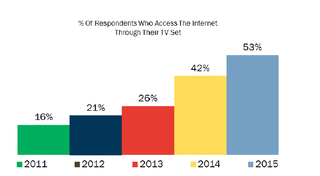Majority of U.S. Households Have Internet-Connected TVs: Magid/TubeMogul Study

For the first time, a majority of U.S. viewers have TV sets connected to the Internet, according to data released today by Frank N. Magid Associates and advertising software maker TubeMogul.
Connected TV penetration--through gaming consoles, set-top boxes, and smart TVs--has more than doubled from 26% of U.S. households in 2013 to 53% this year. The study, based on Magid's online polling of 2,400 Americans last June, found the number rises to 64% among Americans ages 19 to 37.
The trends outlined in the study have broad implications for programming, distribution, advertising and every other corner of the TV and video marketplace. They've been hotly debated throughout this year's edition of CES, which has reached the halfway mark.
The means of connection have shifted dramatically as well as the rise in households. In 2013, 64% of connected homes went through a gaming device. This year, that number decreased to 45%. Smart TV connection grew from 29% to 38%, while Roku’s penetration increased 91% to 21% of households. Similarly, Google Chromecast netted a 14% share in less than two years on the market.
This influx of hardware follows directly behind the expansion of content options. In 2015, subscriptions to Netflix, Hulu, or Amazon Instant Video increased by almost 10 percentage points over 2014 levels, to 62% among the general population and 76% among consumers ages 19-37.
“This mix of big screens, digital content depth, and affordable connectivity hardware goes to show to that connected TV isn’t just here to stay” said Mike Vorhaus, president of Magid Advisors. “It’s beating live TV at its own game. Connected TV is the new TV.”
The study also showed a growing preference for viewing streaming content via TV sets, which is a boon to advertisers concerned about the impact of an impression. TubeMogul’s recently connected TV viewability measurement tool shows 70-90% viewability for directly purchased inventory on content streamed on a TV set reaches the 70% to 90% range.
Broadcasting & Cable Newsletter
The smarter way to stay on top of broadcasting and cable industry. Sign up below
“Connected TV combines the flexible targeting of digital with the engagement of live TV,” said Vorhaus. “Buying connected TV inventory is looking more and more like buying live TV, and that’s a home run for savvy advertisers.”
For the full study, click HERE
